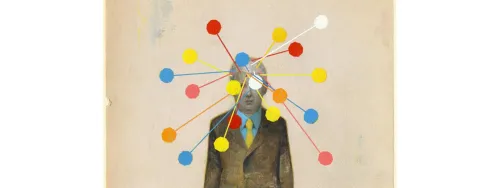
Graphic by Gérard Dubois.
Stanford Medicine News Center - August 15th, 2014 - by Bruce Goldman
Six or so years ago, Frank Longo, MD, PhD, Stanford’s chair of neurology and neurological sciences, was optimistic that a treatment for Alzheimer’s disease was on its way. More than a decade earlier, pharmaceutical companies had begun testing drugs to eradicate one of its hallmark signs — clumps of protein sprinkled randomly throughout the brain. The drugs were antibodies that bind to the protein, called beta amyloid, or A-beta for short.
“They poured a lot of money into clinical trials of these antibodies in Alzheimer’s patients,” Longo said. “And by around five years ago, with the conclusion of early-stage trials, it looked like they might succeed. So, many in the field — including me — had some guarded optimism that when the pivotal phase-3 trials were completed, this approach would have at least some beneficial effect.”
On the order of 30 million people worldwide, including more than 5 million Americans, have Alzheimer’s, the most common form of dementia, which raids the brain and steals a person’s ability to remember, reason and imagine. Barring substantial progress in curing or preventing it, Alzheimer’s will affect 16 million U.S. residents by 2050, according to the Alzheimer’s Association. The group also reports that the disease is now the nation’s most expensive, costing over $200 billion a year. Recent analyses suggest it may be as great a killer as cancer or heart disease.
It’s not really clear what causes the disease, and even rendering a diagnosis involves some guesswork. Genetic factors have been shown to contribute to the likelihood of getting it, but none among them comes close to fully predicting or explaining its onset and progression. What’s known is that the diseased brain is characterized by the protein clumps outside of nerve cells and tangles of fibrous filaments within them, accompanied by an accelerating die-off of those nerve cells. And that there is no cure.
So it was unfortunate that three separate phase-3 trials testing the antibody strategy all failed to have any therapeutic effect on cognition. “I’d like to have something better to offer my patients,” said Longo, who directs the Stanford Center for Memory Disorders. “It’s profoundly disappointing when that doesn’t happen.”
In the wake of this disappointment, research to understand Alzheimer’s has shifted focus. Instead of trying to address signs and symptoms seen in the end stage of disease, researchers are looking at what goes wrong much earlier. Their insights have yielded promising new imaging techniques and new targets for therapeutic drugs, with at least a couple being tested by startup companies Stanford researchers have spun off.
When the brain’s brakes lock up
“By the time visible symptoms of dementia appear and a patient first sees a doctor about it, this process has been under way for years,” said Carla Shatz, PhD, a professor of neurobiology and of biology and the director of Bio-X, Stanford’s interdisciplinary biosciences institute.
A few promising early signals of impending Alzheimer’s do exist — for example, changes in amounts and ratios of certain chemicals in spinal fluid, or the changes observed by investigators via functional brain imaging. But wide-scale spinal taps or brain scans are hardly efficient ways to screen large numbers of people in the hopes of initiating therapeutic interventions earlier — even if there were something to intervene with. What would be great would be to find a molecular mechanism that not only provides a way to detect the approach of Alzheimer’s but also offers a window into the disease process.
Shatz’s recent work has turned up an unexpected player: a molecule once thought to be important only in the immune system but which she discovered over a decade ago also is found in the brain. The molecule, called PirB in mice, is a protein that acts like a brake dialing down the ferocity of the immune response — important if, for example, autoimmunity is to be avoided. Shatz found that in the brain PirB appears to serve as a brake on a different vehicle altogether: the synapse. Synapses are discrete, tiny but critical contact points at which each nerve cell conveys signals to others. Your memories are stored at brain circuits’ synapses. A single nerve cell can sport 10,000 or more synapses, each connecting with a different partner nerve cell. In response to our experience and development, synapses are in a throbbing state of flux: being born, enlarging and strengthening, diminishing and weakening, or disappearing altogether. This relentless fidgeting is the physiological basis of learning, ruminating and daydreaming; of remembering, forgetting and regretting.
But too-much, too-fast alterations in synaptic size and strength could be deleterious. They could, for example, trigger epilepsy. It’s good to have that brake pedal.
Shatz recently found that PirB-deficient mice, even when they’re carrying two mutations that strongly predispose people to Alzheimer’s, develop no symptoms of Alzheimer’s. They get through mazes just fine. Their memories seem intact.
When she and her labmates discovered that small, still-soluble clusters of the infamous A-beta peptide bind very strongly to PirB and that, moreover, PirB concentrated at synapses, she got downright excited. Further experimentation showed that this binding led synapses to break down. Shatz’s lab recently identified the human counterpart to PirB, called LilrB2. If soluble A-beta is triggering synaptic loss long before amyloid plaques become visible, then perhaps inhibiting the A-beta-LilrB2 binding or the chain reaction it sets off could be therapeutic early on, possibly protecting against cognitive deficits.
The immune connection
The brain doesn’t exist in a bottle or a vacuum. It dwells within the body, where it is in constant conversation with the body’s other great communicators — notably the immune and endocrine systems. In August 2013, Ben Barres, PhD, professor and chair of neurobiology, published a study in the Journal of Neuroscience revealing that another protein more typically associated with immune function may be a major early player in neurodegenerative processes.
Examining brains from young and old mice and humans, Barres and his team observed a 300-fold uptick in the prevalence of a particular protein called C1q. “No other protein has ever been shown to increase nearly so profoundly with normal brain aging,” he said. And guess what? This accumulation is concentrated at synapses. The buildup begins precisely in portions of the brain that are the most vulnerable to early neurodegeneration in Alzheimer’s disease, such as the hippocampus. As the brain ages, these C1q deposits spread to synapses throughout the brain.
C1q is no garden-variety protein. As every immunologist knows, C1q bats first on a 20-member team of immune-response-triggering proteins, collectively called the complement system. Abundant in circulating blood, C1q can cling to bacteria or bits of our own dead or dying cells, initiating a molecular chain reaction called the complement cascade. One by one, each of the system’s other proteins gloms on, coating the offending cell or dollop of debris and drawing the attention of immune cells that gobble up the target.
The brain has its own set of immune cells, called microglia, which can secrete C1q. Other cells called astrocytes secrete the rest of C1q’s complement-system “teammates.” The two cell types work analogously to the two tubes of an epoxy kit, in which one tube contains the resin, the other a catalyst.
Barres believes that in the normal aging brain, C1q, but not the other protein components of the complement system, gradually becomes highly prevalent at synapses. By itself, this C1q buildup doesn’t trigger wholesale synapse destruction, or even much affect synaptic health. But it does leave the aging brain’s synapses perched on the brink of catastrophe. An event such as brain trauma, a bad case of pneumonia or perhaps a series of tiny strokes could incite astrocytes — the second tube in the epoxy kit — to start squirting out the other complement-system proteins required for synapse loss. Barres says the brains of Alzheimer’s patients show a 70-fold increase in levels of complement-cascade activity.
A fire burning through the brain
In our early development, our brains sprout a surplus of synaptic connections. This redundancy allows for myriad potential brain circuits, but as we begin logging life experiences, the plethora of synapses becomes an embarrassment of riches. Within any single circuit, an excess of extraneous synaptic connections means noise in the system. Like a sculptor chiseling a statue of cognitive efficiency from raw marble, the brain has tools, including the complement system, for pruning unused or misused synapses during fetal and childhood development. Barres thinks the complement cascade ordinarily becomes quiescent in the adult brain after actively assisting in the “pruning” of redundant or counterproductive synapses during early development, but can get induced by a variety of inflammatory events to turn on again. Long-slumbering synapse-scouring pathways can be awakened by those inflammatory signals, causing massive synapse loss akin to “a fire burning through the brain,” he says.
Annexion, a startup biotechnology company co-founded by Barres, is already making drugs that selectively target elements of the complement cascade. Barres has high hopes. “I believe that drugs that block the complement cascade may not only stop neurodegeneration in Alzheimer’s — and, perhaps, other neurodegenerative disorders — but may buy time to allow the brain to repair lost synapses, quite possibly restoring lost neurological function.” Time will tell. Annexion is actively raising money to finance early-stage, proof-of-principle clinical trials of the new drugs, beginning with patients who have other, easier-to-track neurodegenerative diseases.
More scrutiny of the brain’s immune cells
In their day-to-day life, microglia are beat cops. Among their many roles beyond secreting C1q, one is devouring odd bits of circulating glop or suspended intercellular debris.
Tony Wyss-Coray, PhD, a professor of neurology and neurological sciences, has shown that defects in microglial glop-gobbling capabilities can impair their ability to gobble up early-stage A-beta accumulations, resulting in a buildup of A-beta in aging brains. One rare mutation causing such a defect is known to triple or quadruple Alzheimer’s disease risk. When Wyss-Coray’s team compared autopsied brains from five Alzheimer’s patients and five people who had died of other causes, they found that microglia in the Alzheimer’s patients’ brains were riddled with precisely those A-beta-ingesting defects his group had identified.
Even healthy microglia have anger-management issues. When chronically hyperactivated, as for example occurs in the chronic presence of excessive A-beta, they get stuck in overdrive, squirting out inflammatory substances that can have deleterious effects on brain cells. They also lose their ability to clear the offending A-beta or other toxic substances, generating a destructive inflammatory vicious circle. Katrin Andreasson, MD, professor of neurology and neurological sciences, recently identified a new way of selectively soothing microglial cells, thus halting the cycle of violence and potentially quenching that synapse-destroying “fire burning through the brain” that inflammatory mechanisms appear to induce. She’s continuing this research and hopes the work leads to better anti-inflammatory drugs.
Good news for old brains?
Alzheimer’s is, above all, a disease of old age. Some time ago, Wyss-Coray’s group discovered that something — they weren’t sure what — in the blood of old mice messed up new nerve-cell production and cognitive performance in young mice, and they suspected that young mice’s blood might have a beneficial effect on old brains. In a recently published study in Nature Medicine, Wyss-Coray and his colleagues showed just that. Not only did old mice whose bloodstreams were experimentally interknit with those of young mice exhibit numerous positive neurophysiological changes, but regular old mice given blood plasma from young mice got better at tests of spatial learning, memory and other cognitive functions.
“Exposure to young blood late in life,” Wyss-Coray said, “is capable of rejuvenating an old brain’s nerve-cell function and behavioral performance.” He’s bent on learning what it is in young blood that is recharging the brain. Isolating that factor, or those factors, could lead to pharmacological methods of preventing or delaying the onset of Alzheimer’s in aging people (and that’s all of us). But meanwhile, he’s not waiting around. He’s started a biotechnology company, called Alkahest, to speed the initiation of clinical trials in which Alzheimer’s patients will receive infusions of young donors’ blood and be monitored via brain imaging, standard neuropsychological tests and interviews with patients and caregivers to see if the treatment provides any benefit.
Longo’s group has pioneered the development of small-molecule drugs that target the same receptors used by much bulkier growth-factor proteins involved in restoring nerve cells frayed by conditions such as Alzheimer’s. In animal models, these molecules counteract a number of key Alzheimer degenerative mechanisms, including inflammatory processes, and can restore the loss of synaptic connections in mouse models of late-stage Alzheimer’s disease. One of these compounds has made the rare leap from mouse to human studies and is in early-phase clinical trials sponsored by PharmatrophiX, a company Longo founded before coming to Stanford.
He says he will be happy to see the success of any or all of these diagnostic and therapeutic approaches, most of them geared toward discovering and treating the disease before symptoms get too advanced. And he is particularly happy that his team’s compounds can reverse synapse loss in mice. “We need drugs like this,” he says. “Even if we could stop new Alzheimer’s cases in their tracks, there will always be patients walking in who already have severe symptoms. And I don’t think they should be forgotten.”
(Note: A longer version of this story appeared in the summer 2014 issue of Stanford Medicine magazine.)



